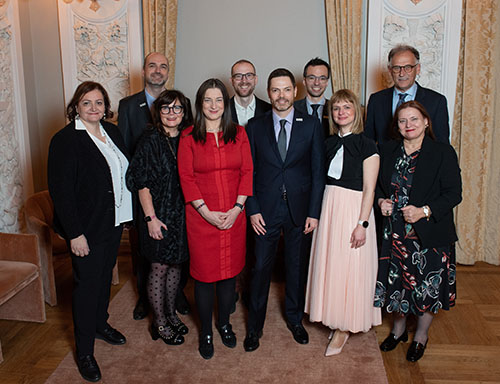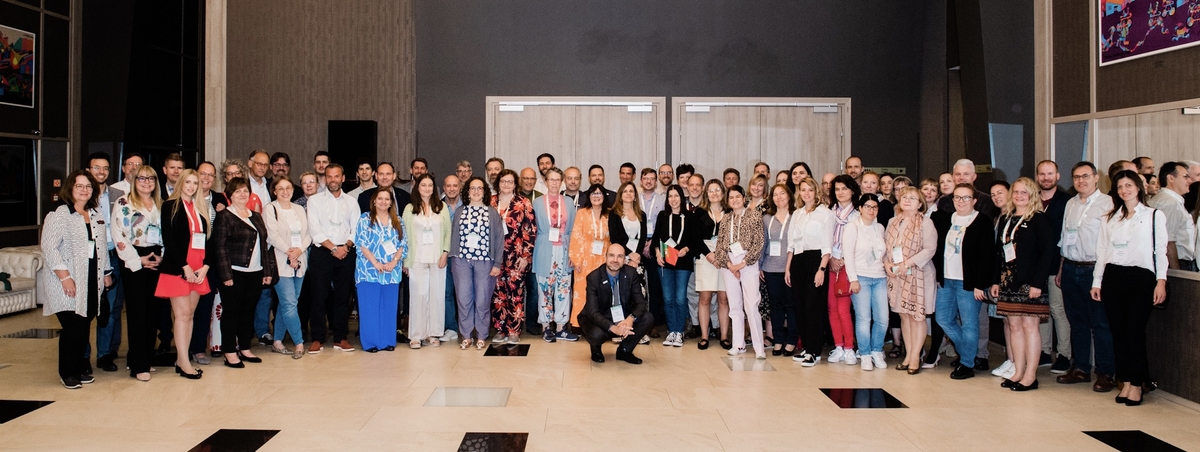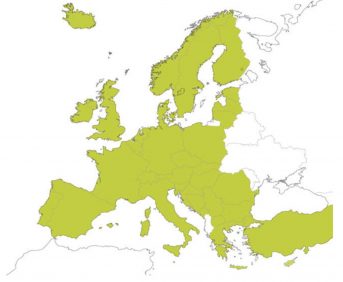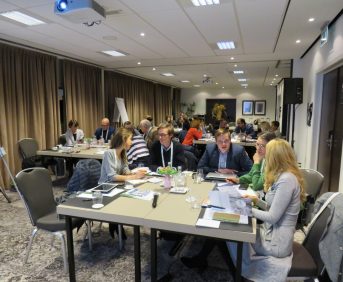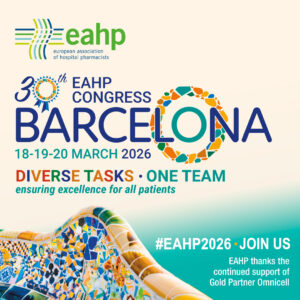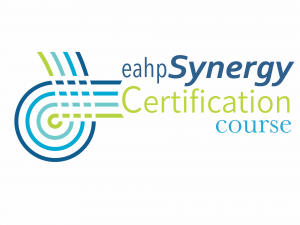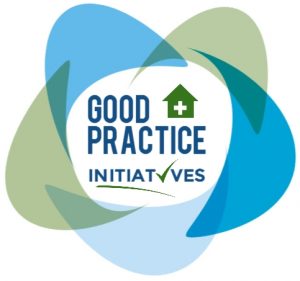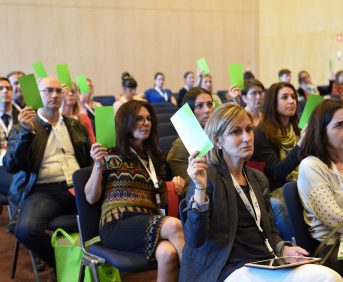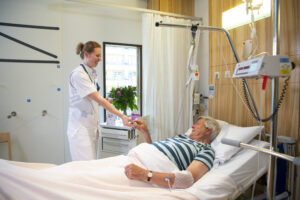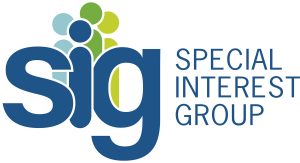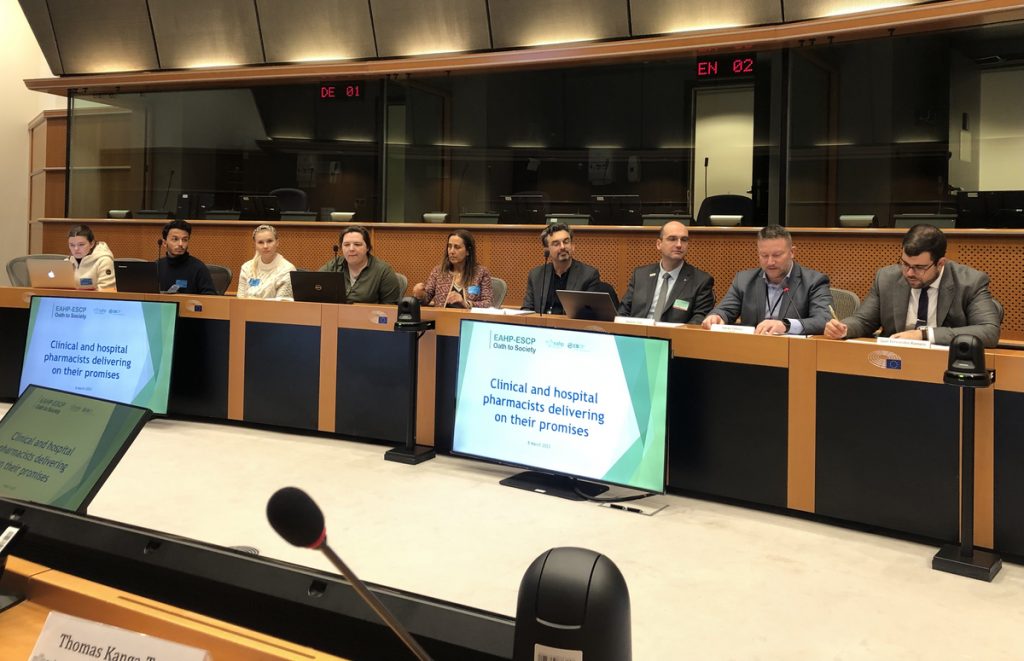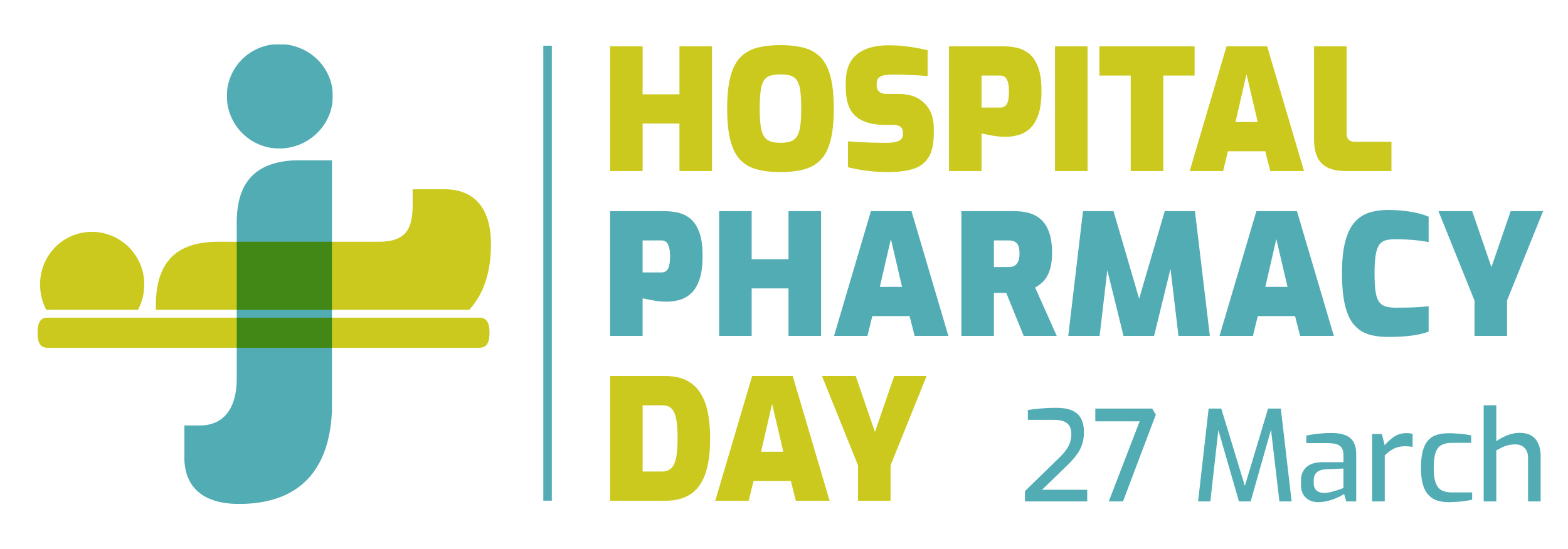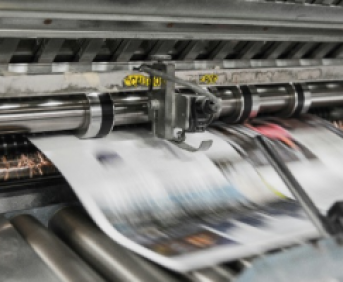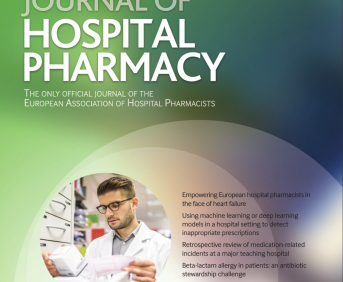DEVELOP A PROTOCOL TO PREPARE MAGISTRAL FORMULAS WHICH INCLUDE HAZARDOUS SUBSTANCES (submitted in 2019)
Pdf

European Statement
Production and Compounding
Author(s)
Lucía Rubio , Mónica Montero
Why was it done?
Hospital Pharmacy Services staff may be exposed to hazardous substances, involving a risk to health. For this reason, is important to identify these substances and measures must be taken to ensure maximum safety for the staff at work. We decided to review the topic when we saw in the Technical Document on Prevention Measures for the Preparation and Administration of Dangerous Drugs, published by the National Institute for Safety and Hygiene at Work (INSHT) there are no specific recommendations for protection of raw materials used in magistral formulas; it only refers to dangerous drugs.
What was done?
Identify health problems involved in handling raw materials that we use in the preparation of magistral formulations. Define personal protective equipment and installations necessary for handling.
Improve work safety of area’s staff.
How was it done?
We have to update raw materials discharged in 2018 in the Pharmacy Service.
The safety data sheets were reviewed in the National Institute for Occupational Safety and Health, paying special attention to dangerous identification and exposure controls/individual protection sections. In this database there is not all the information, so we have to use data sheets of our supplier.
We studied Regulation (EU) Nº 1272/2008 on classification, labelling and packaging of substances and mixtures to determined 3 variables: health dangerous, using hazard class like REPR B, MUTA 2 and STORE RE 1; personal protective equipment and installations must be used in handling of our raw materials.
What has been achieved?
We obtained a list of 20 raw materials. 40% of raw materials aren´t considered hazardous.
Of 60% that are classified as hazardous, they were divided into 2 levels: the first, with categories such as serious eye injuries, skin disorders, respiratory tract irritation or toxicity if swallowed; it includes 75% of raw materials. The second level, which includes the rest of products considered hazardous (25%), is associated with 3 categories: REPR B or possible carcinogenicity, that influence the fertility and development of the fetus; MUTA 2 or genetic defects, that are associated with germ cell or mutations; and STORE RE 1 that can cause damage to organs after prolonged or repeated exposure. For 40% of raw materials there are no specific recommendations about using personal protective equipment. With 60% it is recommended to use self-filtering masks for particles, protective gloves and glasses. For 16% of materials, protective clothing against chemicals is required too. In 65% of raw materials, no specific installation is required to handle them. However, for 25% it is recommended to have well-ventilated areas and with 10% a chemical smoke cabin.
What next?
Most of raw materials we use to make magistral formulations are considered hazardous according to Regulation (EU) nª1272/2008. For this reason, we developed a protocol that included individual protection measures and laboratory equipment necessary to handle such raw materials. So it is possible to normalise the preparation of magistral formulations guaranteeing the safety of the area’s staff. We have devised a plan for review and update of the protocol, following current regulations.
IDENTIFICATION OF HAZARDOUS DRUGS IN EMERGENCY DEPARTMENT: DRUGS CABINET INSPECTION (submitted in 2019)
Pdf

European Statement
Patient Safety and Quality Assurance
Author(s)
Mª Antonia Meroño-Saura, María López-Morte, Taida Rodríguez-Martínez, Pilar Pacheco-López, Consuelo García-Motos
Why was it done?
The publication of the NIOSH list and its application by INSHT in Spain has changed the concept of “Hazardous drug” in terms of its handling and administration, as well as personnel training involved in its management.
What was done?
The main objective is to label every drug considered “Hazardous” and to review the medication included in the Emergency Department kit in a tertiary hospital.
How was it done?
Literature about Hazardous drugs was reviewed. All the drugs included in the Emergency Department kit belonging were identified and classified according to their level published in the NIOSH list. A kit’s review was carried out on site, as well as a Hazardous drugs’ categorisation by adequate labels.
What has been achieved?
6 out of 239 drugs included in the emergency kit were labelled as Hazardous drugs, and could be found in 9 different presentations. Regarding its risk level according to the NIOSH list; chloramphenicol, risperidone and all different presentations of phenytoin were classified as level 2. Acenocoumarol, colchicine/dicycloverine and all different presentations of valproic acid were classified as level 3.
The following incidents were detected;
– Lack of identification: 8 out of the total number of drugs presented identification errors.
– Location error: 4 out of the total number of drugs were not well located.
– Photosensitive: 56 out of the total drugs were photosensitive, of which 11 were not correctly identified or stored.
– Expired drugs: 12 drugs, whose total stock was 399 units. 51 out of the total amount were expired.
After this review, the following measures were carried out:
– Orange labelling for Hazardous drugs’ identification, regardless of their risk level.
– Misidentified drugs were re-labelled, and those that were misplaced were placed in their assigned spot.
– Photosensitive drugs were correctly identified by blue labels and properly preserved.
– Expired drugs were withdrawn.
What next?
Simplifying Hazardous drugs’ identification by a categorisation following a colour code could lead to a safer manipulation by the professionals. During the review of the kit, several incidents were detected and sorted out, which avoided possible medication-related errors. Therefore, it is necessary to establish several control measures in emergency kits in order to avoid errors and improve the safety in the use of drugs.
EXPERIENCE IN THE PHARMACEUTICAL FORMULATION OF IMIQUIMOD SUPPOSITORIES FOR THE TREATMENT OF ANAL CONDYLOMATOSIS: A CASE STUDY (submitted in 2019)
Pdf

European Statement
Production and Compounding
Author(s)
MARIA MUROS ORTEGA, INMACULADA SANCHEZ MARTINEZ, ARANTXA ANDUJAR MATEOS, ISABEL ALARCON FUENTES, FRANSCISCO VALIENTE BORREGO, ANGELA SANCHEZ , ASUNCION SARABIA, ANTONIA RODRIGUEZ, NURIA LUCAS VILLA
Why was it done?
Condylomata acuminata or genital warts are produced by human papillomavirus (HPV). They are considered one of the most common sexually transmitted diseases that must be treated on an individual basis. Imiquimod increases the local immune response mediated by interferon and other cytokines; it is marketed as a 5% cream for topical administration 3 times a week, for a maximum of 16 weeks.
What was done?
The aim of the study is to describe the formulation and results obtained after treatment with imiquimod suppositories manufactured by the Pharmacy Hospital Service.
How was it done?
Suppositories of imiquimod 6.25mg were prepared from Aldara® 5% cream sachets; stearic mass was used as excipient to convey the active principle adding about 2.2g/suppository and molds of 2g for its preparation. The bain-marie was used for fusion and mixing the components. A sterile gauze was included to facilitate extraction if there was anal irritation. The established shelf life was 6 months between 2−8ºC. Suppositories were dispensed individually wrapped in aluminium foil and protected from light added a diptych of information to the patient.
What has been achieved?
The case of a 33-year-old male, VHP 6 positive, with anal condylomatosis and high-grade epithelial dysplasia, most of which had been resected and burned previously without satisfactory results. Imiquimod was added as an adjuvant treatment in suppositories for administration three days a week at night. Twelve suppositories were dispensed each month, and the duration of treatment was 2 months. During treatment the patient reported good tolerance, no itching, no pain in the area of administration. One month after finishing the treatment, no new macroscopic lesions were observed, nor recurrence of previous ones in anoscopic examination.
What next?
The contribution of the Pharmacy Service through the development of imiquimod suppositories has facilitated the achievement of early health results in a complex treatment pathology, allowing rectal administration through suppositories made from a specialty marketed in envelopes for topical use and reducing the duration of treatment to 8 weeks, with very good tolerance on the part of the patient.
References:
1. Bastida C et al. Formulation of imiquimod suppositories for the treatment of intra-anal neoplasms by human papillomavirus. 57th SEFH Congress.
2. PNT elaboration of the Reina Sofía General University Hospital.
3. Lacey C et al. 2012 European guideline for the management of anogenital warts. J Eur Acad Dermatol Venereol 2013 Mar;27(3):e263-70.
4. AEPCC-Guide: Condylomata acuminata. AEPCC Publications, November 2015.
ALGORITHM OF SAFE AND CORRECT PREPARATION OF CHEMOTHERAPY (submitted in 2019)
Pdf

European Statement
Patient Safety and Quality Assurance
Author(s)
Marijana Fortuna, Petra Tavčar, Jure Dolenc, Monika Sonc
Why was it done?
To support us in understanding our role in the preparation of chemotherapy products. To prevent the risk of harm to patients. Recognise prescribed error in pre-documented chemotherapy protocols
What was done?
Cytostatics are carcinogenic, mutagenic and teratogenic drugs. Handling requires a number of organisational and technical systems. All products should be safely and accurately prepared with special care to ensure the highest possible product quality, correct dose, the right patient, the right medicine, the right carrier solutions and right administration, without microbiological and particle contamination. The prescription and preparation of cytostatic drugs must be closely monitored. The most important factor in achieving this is the constant training of pharmacists in pharmaceutical techniques.
How was it done?
This year started with monthly reviews and training in the following subjects by using a written algorithm. Risk to product: Drugs reconstitution negative pressure isolators, leakage/damage or defects of vials, particles, transport and storage. Risk to patient: Incorrect calculations, microbiological contamination, incorrect administration, extravasation, incorrect administration route, incorrect labelling. Risk to operators: Contamination, toxicity, equipment, gloves, cleaning, occupational exposure. All checks have been made throughout the whole of preparation process, adhering to standard operating procedures (SOP-s).
What has been achieved?
We concluded that continuing education by using a writhen algorithm is useful practice. It helps prevent automatic work, remind us to check each step in process and know how to recognise errors in chemotherapy prescriptions and preparation. In 25 cases of prescribed chemotherapy, intervention of a pharmacist was required. In 5 cases of chemotherapy preparation, pharmaceutical techniques have detected a discrepancy in the prescribed therapy.
What next?
Regardless of experience at work, it is necessary to constantly repeat how to work properly, and awareness why we are doing this.
PUBLICATION OF THE FIRST TEXTS IN THE EUROPEAN PAEDIATRIC FORMULARY (submitted in 2019)
Pdf

European Statement
Production and Compounding
Author(s)
Jane Francomb, Dirk Leutner
Why was it done?
Formularies for extemporaneous formulations of paediatric medicines of appropriate quality are currently available in some regions or countries, but no pan-European equivalent exists. Some formulations in use are not appropriate due to a lack of knowledge of best practices. The idea behind the new formulary is to collect, review and then select the most appropriate formulations currently used in Europe which meet today’s requirements.
What was done?
The European Paediatric Formulary was launched at the end of 2019. It is a freely available online publication for pharmacists and clinicians that is intended to provide guidance on the use and preparation of standardised paediatric medicines of an appropriate quality when a suitable licensed medicinal product is not available. The first two monographs and two explanatory texts of the European Paediatric Formulary have now been published by the European Directorate for the Quality of Medicines & HealthCare (EDQM).
How was it done?
Criteria for selection and evaluation of formulations were developed by 2015. Since then the current work is carried out by the European Paediatric Formulary Working Party under the supervision of the European Pharmacopoeia Commission and the European Committee on Pharmaceuticals and Pharmaceutical Care (CD-P-PH). The EDQM provides the scientific secretariat. Monographs for development were prioritised based on patient need. Many formulations currently described in national formularies and other well-established formulations have been gathered from stakeholders throughout Europe. The information available for the most appropriate formulation was transferred into a common format with full quantitative composition details, extemporaneous preparation instructions, validated test methods for quality control and storage conditions.
What has been achieved?
Monographs for hydrochlorothiazide 0.5mg/mL oral solution and sotalol hydrochloride 20mg/mL oral solution were published at the end of 2019. These were accompanied by an introduction and general principles which describe the purpose and content of the European Paediatric Formulary.
What next?
Monographs for Azathioprine oral suspension, Chloral hydrate oral solution, Furosemide oral solution, Isoniazid oral solution, Omeprazole oral suspension and Ranitidine oral solution and a monograph on an oral vehicle are currently under development. Further prioritised items will subsequently be added. Draft monographs for public consultation and final texts will be made available on https://paedform.edqm.eu.
DEVELOPMENT OF GUIDELINES FOR SAFE HANDLING OF ONCOLYTIC VIRUSES (submitted in 2019)
Pdf

European Statement
Clinical Pharmacy Services
Author(s)
Faten Ahmad Díaz, Eugenia Serramontmany Morante, Carla Esteban Sánchez, Pablo Latorre García, Montserrat Carreres-Prieto, Javier Martínez Casanova
Why was it done?
Different critical points were detected: 1) some OV dose prescription depends on tumor size, 2) special storage conditions, 3) special safety measures related to preparation to prevent cross-contamination and technician exposure, 4) special transport conditions in a safety container, and 5) safe administration. The increasing number of clinical trials with OV combined with the identified critical points implies a better coordination between the different departments involved.
What was done?
Development of a standardised working procedure for the safe handling considerations, storage requirements, and modes of administration of oncolytic viruses (OV) in patients with cancer.
How was it done?
Different meetings were arranged with a multidisciplinary team to standardise procedures, in order to avoid errors: 1. The pharmacist validates the prescription volume reflected on the certified sheet according to the tumour size. Then, a pharmacy technician is authorised to remove the vials from the freezer to start the preparation. 2. Special −80ºC freezer is needed to preserve the OV. 3. According to the preventive medicine service, OV must be prepared in biological safety cabinet class II (BSC) with personal protective equipment. At the end of preparation, the BSC must be cleaned with the OV appropriate disinfectant and ventilated for 1 hour before restarting to work again. So, the OV preparation was established at 7 a.m. in order to avoid cross-contamination with the chemotherapy (first preparation in the day). 4. Safety transport must be considered, so OV is packaged in a special hermetic box. 5. The majority of the OV preparations are administered intralesionally at the radiology room so safe administration is needed to avoid the room contamination.
What has been achieved?
By using these procedures, it is possible to work with a single BSC, avoiding delays in the administration of other therapies while reducing the risk of mistakes.
What next?
These types of therapies represent a novel therapeutic modality: their preparation, administration and handling requirements differ from current therapies; pharmacists have an important role in developing new procedures to incorporate them into clinical practice. This protocol may be useful to other centres due to the lack of experience and standardised guidelines to work with this type of therapy.
PRODUCT DOSSIER AND RISK EVALUATION FOR EXTEMPORANEOUS PREPARATIONS KEEPS FOCUS ON PATIENTS (submitted in 2019)
Pdf

European Statement
Production and Compounding
Author(s)
Mette Lethan, Marianne Lund Sørensen, Jakob Kronkvist Hoe, Heidi Waenerlund Poulsen, Louise Rasmussen Duckert
Why was it done?
On July 1st, 2016, an EU resolution caused a new national requirement to establish a PD for new as well as known EP’s produced by the hospital pharmacy. PD’s had to be established for 450 known products in our facilities.
What was done?
A Product Dossier (PD) for extemporaneous preparations (EP) was established in our hospital pharmacy. They contain a risk evaluation and information about the specific value of the preparations, a demonstration that the active pharmaceutical ingredient(s) (API), excipients and containers meet relevant requirements, an evaluation of the stability of the product, and a description of the preparation process and analysis.
How was it done?
To approach the task, an interdisciplinary project group was formed. It consisted of members from Quality Assurance/Control, Stability, Drug Information Center and Production. A formulation for a collaborative approach was established to ensure a high and uniform quality of the PDs. The information obtained included e.g. information and evaluation of API and excipients, ongoing stability studies, indication of the drug and alternative preparations. A few examples were concluded in the group to ensure a quality baseline of the PDs.
What has been achieved?
PDs for 150 products have been successfully implemented. In some cases the formulation regarding excipients was changed to better suit the patient group. In other cases, it was evaluated whether a drug registered in another country could better ensure patient safety. Based on stability data, storing of some products were changed. Collaboration across departments has enabled us to ensure compilations of PDs for our pharmaceutical stock preparations. Completing the PDs on existing products has ensured a pool of knowledge about our products collected in one document and accessible to all departments in the hospital pharmacy.
What next?
Through the interdisciplinary approach PDs ensure focus on the quality, safety and benefits for the patients. All existing EPs will be maintained and evaluated anytime there may be a change in production. For all new products a PD will be prepared according to the guidelines set up. Having the information in one document (PD) ensures that all departments can quickly obtain information needed to consistently maintain and evaluate product quality and thereby the specific value of our production.
IMPROVING ANTIBIOTIC STEWARDSHIP AT A HOME HOSPITAL UNIT BY IMPLEMENTING THE PRODUCTION OF ELASTOMERIC PUMPS CONTAINING BENZYLPENICILLIN (submitted in 2019)
Pdf

European Statement
Production and Compounding
Author(s)
Maria Rautamo, Niina Laihanen , Laura Lehtola
Why was it done?
Erysipelas was the most commonly treated infectious disease at the home hospital unit in 2015. Previously the standard treatment was broad-spectrum antibiotic cefuroxime three times daily. The infectious disease specialist wanted to improve the antibiotic stewardship by shifting from cefuroxime to a continuous infusion of narrow spectrum benzylpenicillin. The aim of the initiative was also to improve patient care and reduce the number of treatment visits and thus overall treatment costs.
What was done?
The production unit at the hospital pharmacy began preparing elastomeric pumps containing benzylpenicillin for Helsinki city home hospital unit for the treatment of outpatients suffering from erysipelas. A pilot study was conducted in November 2018 before further implementation of the elastomeric pumps.
How was it done?
A benzylpenicillin 10 million IU infusion solution was prepared and transferred to elastomeric pumps (Folfusor LV10, Baxter) in the production unit at the hospital pharmacy. The production method was developed by pharmacists at the hospital pharmacy in cooperation with Baxter and the formulation as well as stability information was received from Baxter. The pilot study was planned and executed in cooperation with Helsinki city home hospital unit. The batch size of prepared elastomeric pumps was 7 pumps a week and the overall pilot period consisted of 5 weeks. A total of 8 patients were treated during this period. The opinions of nurses and patients about the use of elastomeric pumps were investigated through a questionnaire. The impact on treatment costs were also evaluated.
What has been achieved?
Elastomeric pumps containing benzylpenicillin have been implemented as a standard treatment for erysipelas at the home hospital unit. Cost savings from the pilot period of 5 weeks were 125 nurse visits corresponding to approximately 100 hours of work as well as 200 km of driving for nurses to patients’ homes. The patients were very pleased with the elastomeric pumps and the fact that the pump had to be changed only once daily.
What next?
Production and delivery of elastomeric pumps containing benzylpenicillin has expanded to other home hospital units. The implementation of elastomeric pumps containing other active ingredients is under investigation.
DIAZOXIDE 10MG/ML ORAL SUSPENSION AS A COST-EFFECTIVE ALTERNATIVE TO THE COMMERCIAL PREPARATION (submitted in 2019)
Pdf

European Statement
Production and Compounding
Author(s)
Beatriz Sánchez Sanz, Iván González Barrios, Siria Pablos Bravo, Sara Ortiz Pérez, Cristian Rosas Espinoza, María Arrieta Loitegui, Francisco Martínez de La Torre, Dolores Canales Sigero, José Miguel Ferrari Piquero
Why was it done?
The objective is the elaboration of a formulation as a cost-effective alternative to the diazoxide oral suspension not commercialised in Spain, to treat patients with hyperinsulinaemic hypoglycaemia.
What was done?
Diazoxide is the first line therapy in infants with hypoglycaemia due to hyperinsulinism. A formulation to facilitate the dosage in newborns has been developed due to the increasing demand at our Hospital.
How was it done?
To evaluate the solubility, a research on Pubmed was executed including terms such as “diazoxide AND solubility” and “tiazides AND solubility”. To determine the stability, the agreement approved by the “Pharmacotechnics Group of the Spanish Society of Hospital Pharmacy” concerning the viability of the non-sterile oral formulations was reviewed. In terms of effectiveness, a retrospective observational study was conducted. Demographic and clinical (duration of the therapy and blood sugar levels 24 hours after first administration, sorted as “sensitive” if those levels were over 60mg/dL) variables were collected.
What has been achieved?
Carboxymethyl cellulose gel 1.5% (CMC) was evaluated as suspending agent, with adequate results. The steps to compounding the formulation of diazoxide 10mg/mL oral suspension were: 1. Four capsules of 25mg were opened and spread over a mortar. 2. 10ml of CMC was measured on a test tube. 3. CMC was added slowly over the powder while stirring the mixture to obtain a homogenized milky creamy. 4. Suspension was stored in an amber bottle. Following our stabilities studies and the lack of preservatives, an expiration date of seven days at ambient temperature was assigned. In our hospital, seven neonates (four males) aged 5.8±2.3 days have been treated with this oral suspension, for an average period of 28 days. Six of them were classified as “sensitive” with levels of 105±30mg/dL while one showed no improvement. Analysing the global expense, one pack of 100 capsules costs €21. Thus, 1 unit of our suspension 10mL cost €0.84 versus 1 bottle of 30mL (€473); the savings are remarkable.
What next?
The preparation constitutes a suitable alternative by using a simple and cheap technique since its introduction. In the future, full studies of stability must be designed to prolong its period of validity and monitor its security.
IMPLEMENTATION OF INTRAVITREAL TISSUE PLASMINOGEN ACTIVATOR INJECTION INTO PRACTICE (submitted in 2019)
Pdf

European Statement
Production and Compounding
Author(s)
Liisa Eesmaa, Katrin Sõnajalg, Ülle Helena Meren
Why was it done?
Intravitreal tissue plasminogen activator (tPA) injection is a guideline recommendation for patients with medium, large or thick submacular haemorrhage mainly due to exudative age-related macular degeneration (AMD). This treatment hasn´t been available: off-label use, rare demand, high price (generic unavailable, the cost uncovered by health insurance).
What was done?
Ophthalmologists contacted the pharmacy to work out a plan for emergent cases of patients with large submacular haemorrhage in the better seeing eye. The pharmacists worked out the logistically simplest, economical affordable solution to prepare the injection in a cleanroom setting.
How was it done?
The pharmacy came up with two models: 1. Compound intravitreal injection (50 μg/dose) from Actilyse 50mg vial (€375) containing substance for intravenous infusion. The rest of the vial would possibly be used in the neurology department during the next 24 hours. The costs would be shared based on microgram use. 2. Use unregistered Actilyse cathflo 2mg vial. Application for permission and delivery would take up to 6 weeks and drug shortages would be usual. The price for 50 μg would be €65. For the first two patients the first model was used. It was logistically complicated for the neurology department as they needed to change their everyday practice. The second model has now been introduced into practice and used for another two cases. It is accepted by the doctors and pharmacists.
What has been achieved?
Four patients have received new treatment with intravitreal tPA in addition to the common practice of pneumatic displacement of the haemorrhage with intravitreal anti-VEGF (vascular endothelial growth factor) injections or intravitreal anti-VEGF monotherapy. The treatment was well tolerated by the patients with some benefit to visual function. The pharmacy is ready to prepare tPA injections during working days. The price of the injection is acceptable.
What next?
The University hospital became interested to start the same treatment. The second model was presented to their hospital pharmacy. Our ophthalmology department is now equipped to inject tPA into the subretinal space during vitrectomy to increase the efficacy of the procedure and improve patients’ visual outcome.
